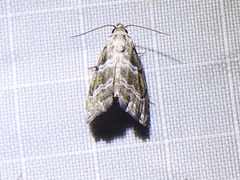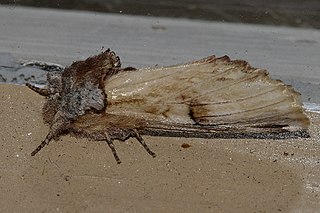Gonodonta nitidimacula is a species of fruit-piercing moth in the family Erebidae. It is found in North America.
Ursia furtiva is a species of moth in the family Notodontidae. It was first described by André Blanchard in 1971 and it is found in North America.
Paradiarsia littoralis, the Labrador dart moth, is a species of cutworm or dart moth in the family Noctuidae. It is found in North America.

Tripudia quadrifera is a species of moth in the family Noctuidae.
Metria bilineata is a species of moth in the family Erebidae.

Abablemma bilineata is a moth species in the family Erebidae. It was first described by William Barnes and James Halliday McDunnough in 1916 and it is found in North America.
Sympistis astrigata is a species of moth in the family Noctuidae. It was first described by William Barnes and James Halliday McDunnough in 1912 and it is found in North America.
Anarta inconcinna is a species of cutworm or dart moth in the family Noctuidae. It was first described by Smith in 1888 and it is found in North America.
Euxoa cinnabarina is a species of cutworm or dart moth in the family Noctuidae first described by William Barnes and James Halliday McDunnough in 1918. It is found in North America.

Oligocentria coloradensis is a species of moth in the family Notodontidae. It was first described by Henry Edwards in 1885 and it is found in North America.
Scevesia angustiora is a species of moth in the family Notodontidae. It was first described by William Barnes and James Halliday McDunnough in 1910 and it is found in North America.
Cryphia flavidior is a species of moth in the family Noctuidae. It was first described by William Barnes and James Halliday McDunnough in 1911 and it is found in North America.

Oligocentria pallida, the pale prominent, is a species of moth in the family Notodontidae. It was first described by Strecker in 1899 and it is found in North America.
Zale bethunei, or Bethune's zale, is a species of moth in the family Erebidae first described by Smith in 1908. It is found in North America.
Tripudia damozela is a species of moth in the family Noctuidae. It was first described by Harrison Gray Dyar Jr. in 1914 and it is found in Central and North America.
Tricholita baranca is a species of cutworm or dart moth in the family Noctuidae. It was first described by William Barnes in 1905 and it is found in North America.
Lacinipolia spiculosa is a species of cutworm or dart moth in the family Noctuidae. It is found in North America.
Homorthodes mania is a species of cutworm or dart moth in the family Noctuidae. It is found in North America.
Unciella primula is a species of moth in the family Noctuidae. It was first described by William Barnes and James Halliday McDunnough in 1918 and it is found in North America.
Tyrissa multilinea is a species of moth in the family Erebidae. It was first described by William Barnes and James Halliday McDunnough in 1913 and it is found in North America.



